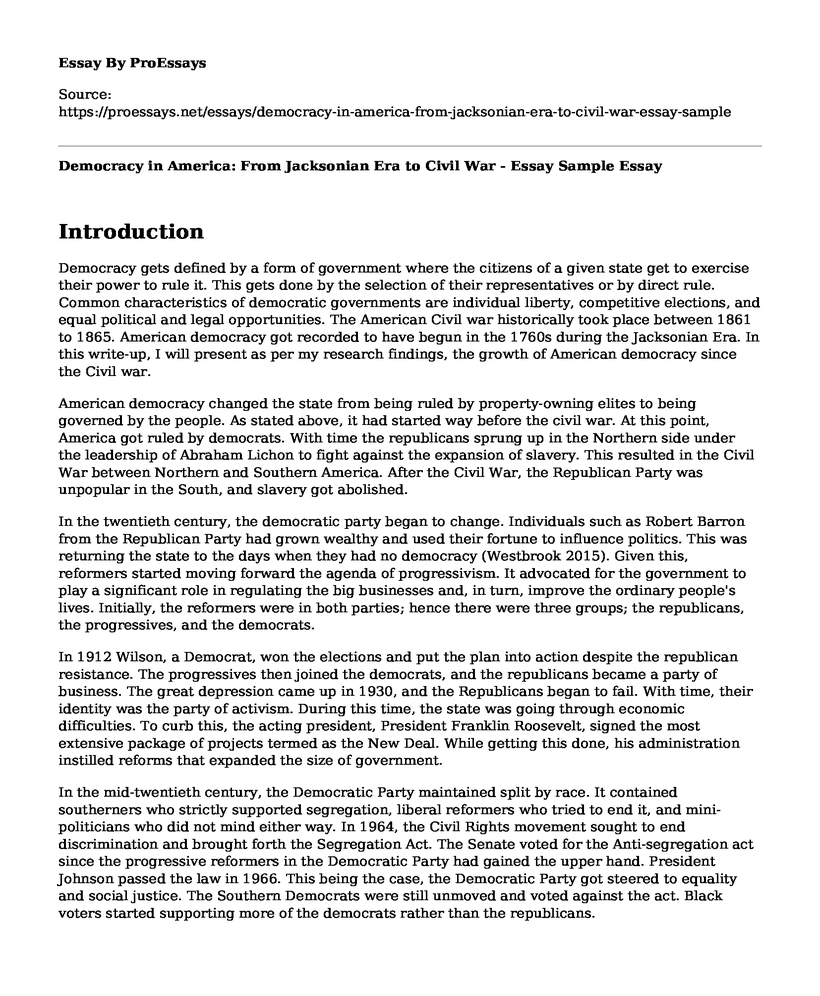Introduction
Democracy gets defined by a form of government where the citizens of a given state get to exercise their power to rule it. This gets done by the selection of their representatives or by direct rule. Common characteristics of democratic governments are individual liberty, competitive elections, and equal political and legal opportunities. The American Civil war historically took place between 1861 to 1865. American democracy got recorded to have begun in the 1760s during the Jacksonian Era. In this write-up, I will present as per my research findings, the growth of American democracy since the Civil war.
American democracy changed the state from being ruled by property-owning elites to being governed by the people. As stated above, it had started way before the civil war. At this point, America got ruled by democrats. With time the republicans sprung up in the Northern side under the leadership of Abraham Lichon to fight against the expansion of slavery. This resulted in the Civil War between Northern and Southern America. After the Civil War, the Republican Party was unpopular in the South, and slavery got abolished.
In the twentieth century, the democratic party began to change. Individuals such as Robert Barron from the Republican Party had grown wealthy and used their fortune to influence politics. This was returning the state to the days when they had no democracy (Westbrook 2015). Given this, reformers started moving forward the agenda of progressivism. It advocated for the government to play a significant role in regulating the big businesses and, in turn, improve the ordinary people's lives. Initially, the reformers were in both parties; hence there were three groups; the republicans, the progressives, and the democrats.
In 1912 Wilson, a Democrat, won the elections and put the plan into action despite the republican resistance. The progressives then joined the democrats, and the republicans became a party of business. The great depression came up in 1930, and the Republicans began to fail. With time, their identity was the party of activism. During this time, the state was going through economic difficulties. To curb this, the acting president, President Franklin Roosevelt, signed the most extensive package of projects termed as the New Deal. While getting this done, his administration instilled reforms that expanded the size of government.
In the mid-twentieth century, the Democratic Party maintained split by race. It contained southerners who strictly supported segregation, liberal reformers who tried to end it, and mini-politicians who did not mind either way. In 1964, the Civil Rights movement sought to end discrimination and brought forth the Segregation Act. The Senate voted for the Anti-segregation act since the progressive reformers in the Democratic Party had gained the upper hand. President Johnson passed the law in 1966. This being the case, the Democratic Party got steered to equality and social justice. The Southern Democrats were still unmoved and voted against the act. Black voters started supporting more of the democrats rather than the republicans.
With this, the white voters moved from the democrats and started supporting the republicans. The reason for this switch was not only based on race but also that they foresaw a bigger government. Between the years 1968 and 1988, the democrats started losing the election to the Republicans by huge margins. With time the US became a demographically non-white state, and the minority voters have made the Democratic Party rise again. The Hispanic population growth between 1980 and 2011 got to be a significant influence on the return of the Democratic Party.
Conclusion
In conclusion, American Democracy grew over the years. It centrally revolved around segregation. Under the leadership of many rulers, the Democratic Party supported segregation until 1964 when this changed. This was its downfall and the rise of the Republican Party. However, as the state turns into a non-white state, the Democratic Party has become the ruling party.
Work cited
Westbrook, Robert B. John Dewey, and American democracy. Cornell University Press, 2015.
Cite this page
Democracy in America: From Jacksonian Era to Civil War - Essay Sample. (2023, Jul 19). Retrieved from https://proessays.net/essays/democracy-in-america-from-jacksonian-era-to-civil-war-essay-sample
If you are the original author of this essay and no longer wish to have it published on the ProEssays website, please click below to request its removal:
- Racial Democracy Essay
- Essay on Politics of Feminism and Democracy
- Essay Sample on Ethical Issues in Multicultural Counseling
- E-commerce Impact on Logistics and Government Shutdown Essays edxample
- Forming Health Policy: A Necessary Step for Healthy Nations - Essay Sample
- Essay Example on Donald Trump's Speech: An Analysis of US Education Systems
- Founding Fathers Established US Government: Press Protects Citizens' Power - Free Paper







